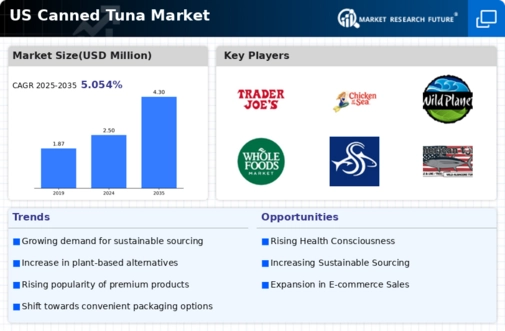The US Canned Tuna Market is characterized by a dynamic competitive landscape where several companies vie for consumer attention in a sector driven by convenience and affordability. Dominated by a few key players, the market sees fierce competition amongst established brands aiming to capture market share while also addressing consumer trends such as sustainability and health consciousness. The increasing demand for protein-rich and ready-to-eat food options has led to innovations in canned tuna products, from a variety of flavors to different packaging formats.
The competitive strategies employed by these companies often involve leveraging brand loyalty, marketing efforts focused on health benefits, and the integration of sustainable fishing practices into their supply chains. Understanding the shifts in consumer preferences alongside regulatory frameworks helps these companies to effectively position themselves in a rapidly evolving marketplace.Bumble Bee Foods is a formidable player in the US Canned Tuna Market, known for its extensive product range which includes both traditional and innovative tuna offerings. The company benefits from a well-established brand that resonates with consumers who prioritize quality and taste.
Its commitment to providing sustainably sourced tuna is a significant strength, helping to build customer trust and loyalty in a market that increasingly favors environmentally friendly practices. Bumble Bee Foods has also successfully invested in marketing campaigns that highlight the versatility of canned tuna, showcasing recipes and health benefits to appeal to a diverse audience. As a result, the company has maintained a strong market presence and continues to adapt its strategies to meet the changing demands of consumers.Ocean Splash has carved out a niche in the US Canned Tuna Market with its focus on premium quality seafood products.
The company specializes in a range of canned tuna offerings that emphasize unique flavor profiles and environmentally responsible sourcing. Its commitment to sustainability resonates well with consumers who are conscious of ocean health and ethical fishing practices. Ocean Splash has effectively leveraged strategic partnerships and collaborations that have not only expanded its product lineup but also strengthened its market position. While the company is recognized for its high-quality products, it has also made strides in enhancing brand visibility through targeted marketing initiatives and promotions.
These efforts are complemented by their growing distribution networks across various retail and online channels, allowing Ocean Splash to connect with a wider audience effectively. As the company continues to innovate and adapt, its reputation for premium quality tuna and commitment to sustainability positions it favorably in the competitive landscape.



















